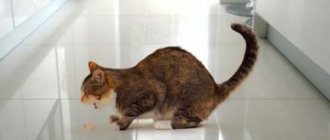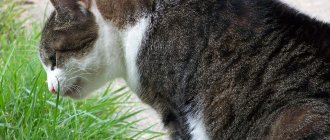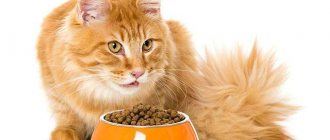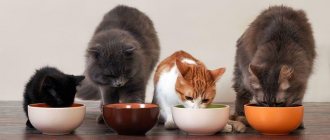Veronica Igorevna Sharipova
veterinarian Petstory
When a cat vomits white foam, most owners immediately contact a veterinarian. Most often, vomiting manifests itself as diseases of the gastrointestinal tract, and these are one of the most common diseases of domestic cats. Later in our article we will look at why a cat may spit up white foam and what to do.
- Help at home
The cat is vomiting white foam: the main thing
- There are many reasons for a cat vomiting white foam, which do not differ in appearance, which is why diagnosis is important.
- If your cat is vomiting white foam, it is important not to self-medicate. The pet's condition can quickly and significantly deteriorate, leading to death.
- It is important to conduct a comprehensive diagnosis so as not to miss concomitant diseases.
- It is always easier to prevent a disease than to treat it. Therefore, it is important to feed your pet properly and do not forget about vaccination and treatment for parasites.
When to contact a veterinarian
Many people try to cope with the problem on their own, but do not know what exactly to do when a cat starts vomiting with white foam. It is strictly forbidden to eliminate this symptom with Cerucal injections or other drugs.
Vomiting is a protective mechanism by which the body gets rid of unnecessary substances. Therefore, if vomiting is repeated in an animal more than 2 times a day, accompanied by depression and other clinical signs, then contacting a veterinarian is a mandatory procedure.
Causes of vomiting white foam
There are many reasons for cats vomiting white foam, the most common of which we will consider below.
Natural causes
Wool
Hair vomiting is a fairly common occurrence in domestic cats, especially long-haired cats. The fact is that when cats wash themselves, they swallow a huge amount of hair every day, which can begin to get tangled and form a lump in the stomach. Usually, after being rolled into a fairly voluminous sausage, it comes out vomiting.
Grass
Often, to prevent hair vomiting and to cleanse the stomach, owners give cats grass to chew. Moreover, street cats often perform this procedure on their own: the grass is not digested and causes vomiting, along with hair and other foreign objects coming out of the stomach.
Feed
Vomiting after eating without reference to the time of feeding often occurs in cats with inappropriate nutrition. Vomiting also occurs after eating cold food due to irritation of the stomach receptors.
Hunger
If your cat vomits white foam, it may be due to hunger. The fact is that cats in nature eat often, but little by little. They have a relatively small stomach, which is not adapted to either eating a large portion of food at once or to prolonged hunger. Therefore, in no case should the intervals between feedings be more than 12 hours.
Binge eating
Typically, vomiting as a result of overeating occurs in small kittens and street animals that have been hungry for a long time. Despite the fact that it is recommended to feed cats ad libitum, in this case it is important to ration portions - give food often, but a little at a time.
Foreign body
Cats, especially young ones, are very curious by nature. Therefore, sometimes they can swallow inedible objects: strings, toys, bags. In some cases, foreign objects are passed through vomit or feces, but can also cause a blockage in the gastrointestinal tract. And this leads to constant vomiting of white foam and requires immediate surgical intervention. Sometimes a cat simply vomits saliva, but this does not mean that there is no foreign object.
Pregnancy
Cats sometimes vomit during pregnancy, but this is not normal. The so-called period of toxicosis in cats has not been described, and the cause of vomiting may be intoxication of the body or other pathologies of pregnancy.
Estrus
In young cats, vomiting during estrus as a result of nervous overexcitation may be normal. But if vomiting repeats several times and the pet stops eating, then this is a reason to contact a veterinary clinic.
Medicines
Vomiting due to medications can occur either as a result of eating medications or as an adverse reaction to prescribed treatment. In each specific case, the solution to the problem is developed individually depending on the type of drug.
Stress
Most cats are very delicate creatures that are subject to constant stress. Moreover, in addition to the obvious causes of stress (the appearance of a new pet, small children, the arrival of guests in the house), there are also hidden from the eyes of the owner. For example, a pet may be upset by an inappropriately sized tray, an unpleasant smell of litter, a lack of scratching posts, a quiet hiding place, or simply boredom. If during stress your cat starts vomiting or refuses to eat, you need to urgently look for the reasons.
Surgical interventions
Vomiting on the first day after surgery and anesthesia is normal, as this is one of the side effects of the drugs. But if vomiting appears on the second day after surgery and beyond, you must immediately contact the clinic.
Vaccination
In most cases, pets are vaccinated without any adverse reactions. If your pet vomits once after the procedure, do not worry. It is likely that the stress after transporting and visiting the clinic for the animal is to blame - often in such cases you will notice not vomiting in the cat, but white foam from the mouth.
Possible diseases
Viral infections
Viral infections, especially feline panleukopenia, can cause vomiting and refusal to eat. It is not recommended to self-medicate in such situations, as you can waste time and trigger the disease.
Pathologies of the digestive system
Pathologies of the digestive system are one of the most common causes of vomiting. These include gastritis, duodenitis, pancreatitis, cholangitis, colitis and other diseases. In these cases, only a veterinarian can determine the cause of vomiting, make an accurate diagnosis and prescribe treatment.
Kidney diseases
Most older pets are susceptible to kidney disease, but similar pathologies can also occur in young pets as a result of poisoning or the presence of hereditary pathologies. Vomiting in this situation develops due to poisoning of the body with metabolic products that are not excreted by diseased kidneys.
Sepsis
Sepsis, or blood poisoning, is a severe complication of an infectious process, injury, and also a consequence of failure to maintain sterility during or after surgery. Sepsis is a life-threatening condition and, unfortunately, is not always treatable. In this situation, vomiting develops due to severe intoxication of the body.
Oncology
In the modern world, neoplasms in cats, unfortunately, are becoming more and more common. Moreover, a tumor can develop in a very young animal. If your cat has a tumor in the stomach or intestines, it is most likely causing the white vomit.
Helminths
Oddly enough, most owners believe that keeping cats in an apartment cannot cause worms. But, as practice shows, this is a common and very dangerous misconception. A pet can become infected with worms not only from eating raw meat, but also from the owner who brought their eggs into the apartment with shoes. The presence of a large number of worms in a cat’s body often leads to vomiting. It is especially common for kittens to vomit white foam due to worms.
Hurry up, choose a box and find out what gift awaits you
Discount on pet insurance
Promo code copied to clipboard
How to give first aid
First aid for vomiting
Vomiting is a normal protective reaction of the body. Most often, cats vomit when they overeat, swallow their fur or large pieces of food. If after vomiting the cat feels well, plays, runs, has normal bowel movements, and a healthy appetite, then there is no reason to worry. It is enough to observe the animal during the day.
If your cat is overeating, do not feed it for 12 hours. Such unloading will benefit the body.
If your cat suddenly vomits white foam and liquid, you need to take some measures.
1. Provide plenty of fluids. Place a bowl of water in a visible place.
2. If the animal does not drink water, you need to give it water every 2 hours from a syringe or pipette.
3. If vomiting is accompanied by diarrhea, you can give Smecta powder after mixing it in warm water.
4. Within three days after poisoning, include low-fat foods in your diet.
In cases where the cat vomits frequently over a short period of time, and when vomiting blood or bile is released, you need to contact a veterinarian.
Diagnosis of the problem
In order to understand why the cat is vomiting white foam and what to do next, it is necessary to conduct a comprehensive examination. Diagnosis should include general and biochemical blood tests, abdominal ultrasound and x-rays. The fact is that vomiting is a nonspecific symptom. And, as we have already discussed above, it can have a large number of causes, and there may not be other accompanying symptoms. Moreover, by prescribing symptomatic treatment (for example, malt paste - if vomiting due to fur is suspected, or anthelmintic - if worms are suspected), you may miss time for diagnosing and treating a more serious disease. Therefore, in most cases, in the presence of vomiting, doctors insist on a full diagnosis.
In some cases, especially to rule out a tumor, a CT scan may be needed.
In case of one-time vomiting caused by fur, eating grass, overeating, hunger or vaccination , provided that the pet has an appetite, you can monitor its condition without going to the clinic right away. If vomiting recurs, it is necessary to exclude other causes and conduct a full examination.
Also, when vomiting hair, it is recommended to pay attention to the grooming of the pet - comb it out more often, and during the molting period - give a special paste that helps remove hair from the body (malt paste).
If vomiting is caused by inappropriate food , and your pet has no other health complaints, you can try changing the diet and observing the changes. A similar principle applies to vomiting due to helminths - giving anthelmintics can completely solve the problem.
If vomiting occurs during pregnancy or estrus, an ultrasound scan of the abdominal cavity is required to examine the condition of the uterus and ovaries.
Vomiting due to stress . In this situation, a trip to the clinic can only worsen the pet’s condition. In this case, a good solution would be to contact a veterinarian online (ideally, a zoopsychologist). A specialist will help identify the cause of stress and, if necessary, prescribe sedatives.
Vomiting after taking any medications requires a mandatory visit to the clinic and drawing up a diagnostic plan depending on the specific drug. If vomiting occurs due to the use of antibacterial, painkillers and other drugs, the doctor will select an alternative treatment.
a foreign body or oncology is suspected, an ultrasound and x-ray of the abdominal cavity should be performed. If necessary, the doctor will prescribe other tests.
When vomiting due to viral infections, after surgery or due to sepsis, blood tests are required first of all to assess the general condition of the body.
If you suspect a pathology of the digestive system or kidney disease, an ultrasound of the abdominal cavity and blood tests are necessary to identify both the anatomical signs of the disease and the severity of the process.
Symptoms of dyspepsia
Symptoms of dyspepsia can manifest themselves in different ways, depending on the specific type of disorder, but there are signs that are simultaneously characteristic of all types of the disease.
Different types of dyspepsia have the following common symptoms:
- the appearance of unpleasant sensations in the so-called espiral area, that is, in the upper abdomen. The patient experiences feelings of bloating and heaviness, sometimes pain of varying intensity occurs;
- belching. Rare isolated cases of belching are not signs of the disease. Dyspepsia is indicated only by constant frequent belching;
- nausea, heartburn. The patient experiences an unpleasant burning sensation in the upper abdomen, as well as in the chest area. This sensation appears when aggressive stomach contents enter the esophagus. Normally, such phenomena should not happen;
- flatulence. A feeling of bloating, as well as increased gas production, can be caused by increased formation of gases in the intestines;
- bowel disorder. Patients who suffer from dyspepsia have irregular, usually frequent, bowel movements.
Dyspepsia, which is caused by a lack of digestive enzyme, has the following symptoms:
- nausea;
- unpleasant taste in the mouth;
- transfusion and rumbling in the abdomen, malaise, weakness;
Sometimes patients experience headaches and insomnia. Stool often contains large amounts of food that is poorly digested.
Functional dyspepsia is manifested by such unpleasant symptoms as pain, discomfort in the pancreas after eating, accompanied by heaviness, fullness, and early satiety.
Fermentative dyspepsia. The main symptoms of fermentative dyspepsia are bloating of the intestines with the release of a large amount of gases, frequent liquid foamy stools with a sour odor. Abdominal pain is tolerable or absent. A very typical sign of fermentative dyspepsia is the nature of bowel movements. They are lightly colored, contain few gas bubbles, a large amount of starch grains, fiber, iodophilic microbes and organic acids.
Putrid dyspepsia is in many ways reminiscent of intoxication: the patient feels weakness and general malaise, feels nausea and a severe headache. The stool is dark and liquid, has an unpleasant and rather pungent odor, and stools are frequent.
Fatty dyspepsia , unlike other types of dyspepsia, is not characterized by frequent diarrhea. Patients suffering from fatty dyspepsia experience a feeling of fullness and heaviness in the abdomen, complain of flatulence and belching, as well as severe pain that begins half an hour after eating. Feces have a whitish color and a greasy sheen: these are the remains of fat that does not have time to be digested. The stool is plentiful.
Dyspepsia in young children manifests itself in regurgitation and bloating. The stool is frequent, more than six times a day, the stool is green, and there are whitish flakes. At the same time, the child is capricious, sleeps and eats poorly.
Treatment
Treatment for single vomiting caused by wool, grass, overeating, hunger or vaccination is usually not required. If vomiting recurs and the pet’s condition worsens (refusal to eat, lethargy), a visit to the clinic is mandatory.
If you are vomiting due to food, you need to reconsider your diet. When feeding with industrial food, you need to try options for sensitive digestion, and when eating a homemade diet, contact a nutritionist to create a proper and balanced diet.
Vomiting due to estrus or pregnancy requires treatment if there is any pathology. In case of estrus, which is constantly severe, sterilization may be recommended, and in case of pregnancy pathology, its termination.
Vomiting due to stress in each specific case requires an individual approach. Only a doctor can detect and help eliminate the cause of a cat’s stress, as well as select an individual regimen for administering sedatives.
In case of vomiting caused by helminths , deworming is mandatory. To determine the frequency of treatments and select the right drug, it is recommended to contact a veterinary clinic or contact a veterinarian online. Under no circumstances should you use medications - they can poison the animal.
If vomiting is caused by the presence of a foreign body in the pet's stomach or intestines, surgical intervention is necessary. In this situation, it is strongly recommended not to use petroleum jelly and other folk remedies, as you may waste precious time. If the condition is neglected, pets may develop intestinal necrosis and severe intoxication of the body, often leading to death.
For vomiting caused by other causes (drug poisoning, oncology, kidney disease, etc.) , treatment is developed individually in each case and depends on many factors (age of the pet, presence of concomitant pathologies, severity of the disease, etc.).
Help at home
You can help your pet at home only if the vomiting occurred once and he is in good health and has no other complaints. For example, if an animal vomits something that it recently ate, there is no need to give it anything.
It is also not recommended to self-prescribe antiemetic drugs, as they can not only blur the picture of the disease, but also worsen the pet’s condition (for example, when eating a foreign object).
Diet
For most diseases of the gastrointestinal tract, manifested by vomiting, a diet (food labeled Gastro Intestinal) can help. But it is worth considering that, for example, in case of vomiting caused by kidney disease, a different diet is needed (food labeled Renal). When feeding your pet homemade products, a consultation with a veterinarian nutritionist is necessary to correct the diet.
Preventive measures and nutrition
To avoid troubles with the digestive tract and other ailments, you should know and follow preventive measures:
- Vaccinate your animal every year. Deworming should be done every three months.
- Visit the veterinary clinic regularly - this way you will be calm about the health of your pet. For healthy animals, a scheduled visit should take place once a year, for older animals or animals with chronic diseases - more often.
- Choose good veterinary clinics and trusted specialists. Only they will be able to give the correct advice and prescribe the correct treatment if necessary. Ideally, the animal should have its own therapist.
- An important preventative measure is a well-balanced diet. It should be of the highest quality: buy only proven feed. Don’t forget to give herbs to cleanse and heal the body.
- Groom your cat's fur thoroughly from time to time. You need to comb the animal, bathe it, and cut it - especially if it has long and thick hair. Pay extra attention to your cat's fur during the shedding period.
- Stay safe. You should not leave small and sharp objects that can be swallowed by your pet within easy reach. Put everything in a locked cabinet and check the floor regularly.
You shouldn’t always panic if your cat vomits white foam - it’s quite possible that this is a one-time physiological reaction. If attacks occur repeatedly and are accompanied by suspicious symptoms, consult a veterinarian.
The article is for informational purposes only. Contact your veterinarian!
Do you like the article? 693
What should you do if your kitten vomits white foam?
If a kitten is vomiting white foam, do not self-medicate under any circumstances, only doctors know what to do. Kittens have a very fast metabolism, and if he spits up white foam, he can instantly develop dehydration, which will lead to the death of the pet. Therefore, to make a diagnosis and prescribe treatment, you should immediately consult a doctor.
Symptoms of laryngopharyngeal reflux
- Dysphonia or hoarseness;
- cough;
- feeling of a lump in the throat;
- discomfort and feeling of mucus in the throat;
- dysphagia (impaired swallowing).
Some researchers believe that chronic irritation of the larynx may lead to the development of carcinoma in patients who do not drink alcohol or smoke, although there is no data to support this.
Symptoms characteristic of LPR may also be caused by the following conditions:
- postnasal drip;
- allergic rhinitis;
- vasomotor rhinitis;
- upper respiratory tract infections;
- habitual coughing;
- use of tobacco or alcohol;
- excessive use of voice;
- changes in temperature or climate;
- emotional problems;
- environmental irritants;
- vagal neuropathy.
Prevention
Given the variety of reasons that can cause white foam vomiting, the main preventative measures include proper feeding and maintenance of the pet.
For example, when feeding your pet with professional premium food, the risk of vomiting due to poisoning or digestive system disease is minimized. Timely vaccination protects your pet from vomiting due to viral infections. To prevent hair vomiting during the molting period, cats need to be thoroughly combed and given special preparations that facilitate the removal of hair from the body (malt paste). To prevent starvation vomiting, cats need to be fed small, frequent meals or given ad libitum.
It is also important to provide the cat with leisure time in the house. When a cat interacts with special play complexes, scratching posts made of various materials, and safe toys, the risk of vomiting as a result of eating foreign objects due to boredom is reduced.
It is advisable to sterilize cats that are not involved in breeding to prevent incessant estrus and unwanted pregnancies.
Unfortunately, not all diseases can be prevented. Diseases of the kidneys, heart and other organs, accompanied by vomiting, are often hereditary. There is no way to prevent them.
Pivot table
| Cause | What to do |
| Wool | Regular brushing, malt paste |
| Grass | Observation |
| Feed | Power change |
| Hunger | Feed more often |
| Binge eating | Feed more often and in small portions |
| Foreign body | Treatment in a clinic setting |
| Pregnancy | Diagnostics |
| Estrus | Diagnostics |
| Medicines | Treatment in a clinic setting |
| Stress | Eliminating stress and prescribing sedatives |
| Surgical interventions | Treatment in a clinic setting |
| Viral infections | Treatment in a clinic setting |
| Vaccination | Vomiting is often one-time, no treatment required |
| Pathologies of the digestive system | Treatment in a clinic setting |
| Kidney diseases | Treatment in a clinic setting |
| Oncology | Treatment in a clinic setting |
| Sepsis | Treatment in a clinic setting |
| Helminths | Treatment for helminths |











